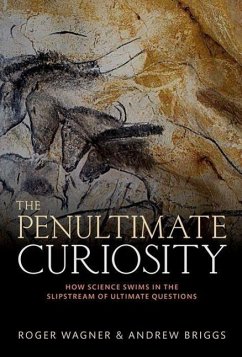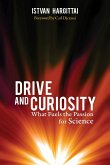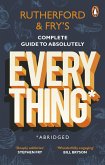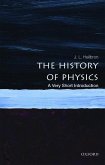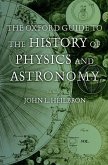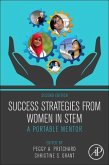Roger Wagner, Andrew Briggs
The Penultimate Curiosity
How Science Swims in the Slipstream of Ultimate Questions
Roger Wagner, Andrew Briggs
The Penultimate Curiosity
How Science Swims in the Slipstream of Ultimate Questions
- Gebundenes Buch
- Merkliste
- Auf die Merkliste
- Bewerten Bewerten
- Teilen
- Produkt teilen
- Produkterinnerung
- Produkterinnerung
This book sets out to answer one of the most profound questions about the development of human thought: why it is that throughout the long journey from cave painting to quantum physics what we now refer to as 'science' and 'religion' have been so closely entangled.
Andere Kunden interessierten sich auch für
![Drive and Curiosity Drive and Curiosity]() Istvan HargittaiDrive and Curiosity22,99 €
Istvan HargittaiDrive and Curiosity22,99 €![Intellectual curiosity and the Scientific Revolution Intellectual curiosity and the Scientific Revolution]() Toby E. HuffIntellectual curiosity and the Scientific Revolution32,99 €
Toby E. HuffIntellectual curiosity and the Scientific Revolution32,99 €![Rutherford and Fry's Complete Guide to Absolutely Everything (Abridged) Rutherford and Fry's Complete Guide to Absolutely Everything (Abridged)]() Adam RutherfordRutherford and Fry's Complete Guide to Absolutely Everything (Abridged)9,99 €
Adam RutherfordRutherford and Fry's Complete Guide to Absolutely Everything (Abridged)9,99 €![Curiosity and the Desire for Truth Curiosity and the Desire for Truth]() Velvl GreeneCuriosity and the Desire for Truth20,99 €
Velvl GreeneCuriosity and the Desire for Truth20,99 €![The History of Physics: A Very Short Introduction The History of Physics: A Very Short Introduction]() J L HeilbronThe History of Physics: A Very Short Introduction11,99 €
J L HeilbronThe History of Physics: A Very Short Introduction11,99 €![The Oxford Guide to the History of Physics and Astronomy The Oxford Guide to the History of Physics and Astronomy]() John L. Heilbron (ed.)The Oxford Guide to the History of Physics and Astronomy67,99 €
John L. Heilbron (ed.)The Oxford Guide to the History of Physics and Astronomy67,99 €![Success Strategies from Women in Stem Success Strategies from Women in Stem]() Success Strategies from Women in Stem37,99 €
Success Strategies from Women in Stem37,99 €-
-
-
This book sets out to answer one of the most profound questions about the development of human thought: why it is that throughout the long journey from cave painting to quantum physics what we now refer to as 'science' and 'religion' have been so closely entangled.
Produktdetails
- Produktdetails
- Verlag: Sinauer Associates Is an Imprint of Oxford University Press
- Seitenzahl: 496
- Erscheinungstermin: 25. April 2016
- Englisch
- Abmessung: 246mm x 174mm x 38mm
- Gewicht: 1062g
- ISBN-13: 9780198747956
- ISBN-10: 0198747950
- Artikelnr.: 44515136
- Verlag: Sinauer Associates Is an Imprint of Oxford University Press
- Seitenzahl: 496
- Erscheinungstermin: 25. April 2016
- Englisch
- Abmessung: 246mm x 174mm x 38mm
- Gewicht: 1062g
- ISBN-13: 9780198747956
- ISBN-10: 0198747950
- Artikelnr.: 44515136
Roger Wagner has been described by Charles Moore as the "best religious painter in Britain today". He gained first class honours in English Literature at Oxford, and then studied for three years at the Royal Academy before returning to live in Oxford and paint full time. Both The Ashmolean Museum at Oxford and The Fitzwilliam Museum at Cambridge have his work in their permanent collections. He has produced several books of illustrated poems and translations of the Psalms. Since 2010 he has taught at the Ruskin School of Art. A book about his work Forms of Transcendence The Art of Roger Wagner by Chris Miller was published in 2009. His 2012 Gresham College lecture was published on the web http://www.youtube.com/watch?v=uMb8rIQbTGc. His new stained glass window was installed in St Mary's Iffley in 2012. He was commissioned to paint the first portrait of Justin Welby as Archbishop of Canterbury, which in 2014 was hung in Auckland Castle. Andrew Briggs was elected in 2002 as the first holder of the newly created Chair in Nanomaterials at the University of Oxford. After studying physics at Oxford he gained a PhD at the Cavendish Laboratory in Cambridge, where the inscription from the Psalms was placed over the entrance of the new laboratory at his initiative. He then studied for a degree in Theology at Cambridge, winning the Chase Prize for Greek, before returning to Oxford in 1980 to pursue an academic career in science. In what is now the Department of Materials he has been successively Royal Society Research Fellow, University Lecturer, Reader, and Professor. His scientific research focuses on materials and techniques for quantum technologies, in which non-classical superposition and entanglement are harnessed for future applications such as computers and information processors. Simultaneously his experiments also probe foundational questions such as the nature of reality in the context of quantum theory.
PART I: In the Beginning I
1: The First Men
2: Tentasali
3: Watauinawa
4: The Garden of Eden Moment
5: Primate Parallels
6: Horizons of Curiosity
7: Ultimate Curiosity
PART II: God Driven Science
8: The Lions of Miletus
9: The Move to Athens
10: Through the Academy Door
PART III: Encounters in Alexandria
11: Two Students
12: The Divided City
13: Industrious Jack
14: The Creation of the World
PART IV: The Long Argument
15: The Dream of Aristotle
16: Al Ghazali's Pilgrimmage
17: A Tale of Two Cities
18: Imposed Silence
19: Experimental Science
20: The Universal Law
PART V: The Open Book of Heaven
21: Against Aristotle
22: Free Philosophising
23: The Freedom of Intellect
24: Simplicius Reborn
25: The Creation
PART VI: Priests of Nature
26: A New Era
27: A Lutheran Astrologer
28: The Experimental Philosophy
29: The Oxonian Sparkles
PART VII: The Ocean of Truth
30: Le Grand Newton
31: The Beautiful System
32: Mathematical Theologies
33: The Coast of Infinity
PART VIII: Voyages of Discovery
34: Two Journeys
35: The Mystery of Mysteries
36: The Creed of Science
PART IX: In the Beginning II
37: The Literary Inquest
38: Breaking the Seals
39: The Intellectual Picklock
40: In a Strange Land
41: By the waters of Babylon
42: Adan and Adapa
43: Ariadne's Thread
PART X: Through the Laboratory Door
44: Science in a Time of Cholera
45: A Visit to the Museum
46: Experiments of Thought
47: The Unity of Nature
48: The Works of the Lord
PART XI: Epilogue
1: The First Men
2: Tentasali
3: Watauinawa
4: The Garden of Eden Moment
5: Primate Parallels
6: Horizons of Curiosity
7: Ultimate Curiosity
PART II: God Driven Science
8: The Lions of Miletus
9: The Move to Athens
10: Through the Academy Door
PART III: Encounters in Alexandria
11: Two Students
12: The Divided City
13: Industrious Jack
14: The Creation of the World
PART IV: The Long Argument
15: The Dream of Aristotle
16: Al Ghazali's Pilgrimmage
17: A Tale of Two Cities
18: Imposed Silence
19: Experimental Science
20: The Universal Law
PART V: The Open Book of Heaven
21: Against Aristotle
22: Free Philosophising
23: The Freedom of Intellect
24: Simplicius Reborn
25: The Creation
PART VI: Priests of Nature
26: A New Era
27: A Lutheran Astrologer
28: The Experimental Philosophy
29: The Oxonian Sparkles
PART VII: The Ocean of Truth
30: Le Grand Newton
31: The Beautiful System
32: Mathematical Theologies
33: The Coast of Infinity
PART VIII: Voyages of Discovery
34: Two Journeys
35: The Mystery of Mysteries
36: The Creed of Science
PART IX: In the Beginning II
37: The Literary Inquest
38: Breaking the Seals
39: The Intellectual Picklock
40: In a Strange Land
41: By the waters of Babylon
42: Adan and Adapa
43: Ariadne's Thread
PART X: Through the Laboratory Door
44: Science in a Time of Cholera
45: A Visit to the Museum
46: Experiments of Thought
47: The Unity of Nature
48: The Works of the Lord
PART XI: Epilogue
PART I: In the Beginning I
1: The First Men
2: Tentasali
3: Watauinawa
4: The Garden of Eden Moment
5: Primate Parallels
6: Horizons of Curiosity
7: Ultimate Curiosity
PART II: God Driven Science
8: The Lions of Miletus
9: The Move to Athens
10: Through the Academy Door
PART III: Encounters in Alexandria
11: Two Students
12: The Divided City
13: Industrious Jack
14: The Creation of the World
PART IV: The Long Argument
15: The Dream of Aristotle
16: Al Ghazali's Pilgrimmage
17: A Tale of Two Cities
18: Imposed Silence
19: Experimental Science
20: The Universal Law
PART V: The Open Book of Heaven
21: Against Aristotle
22: Free Philosophising
23: The Freedom of Intellect
24: Simplicius Reborn
25: The Creation
PART VI: Priests of Nature
26: A New Era
27: A Lutheran Astrologer
28: The Experimental Philosophy
29: The Oxonian Sparkles
PART VII: The Ocean of Truth
30: Le Grand Newton
31: The Beautiful System
32: Mathematical Theologies
33: The Coast of Infinity
PART VIII: Voyages of Discovery
34: Two Journeys
35: The Mystery of Mysteries
36: The Creed of Science
PART IX: In the Beginning II
37: The Literary Inquest
38: Breaking the Seals
39: The Intellectual Picklock
40: In a Strange Land
41: By the waters of Babylon
42: Adan and Adapa
43: Ariadne's Thread
PART X: Through the Laboratory Door
44: Science in a Time of Cholera
45: A Visit to the Museum
46: Experiments of Thought
47: The Unity of Nature
48: The Works of the Lord
PART XI: Epilogue
1: The First Men
2: Tentasali
3: Watauinawa
4: The Garden of Eden Moment
5: Primate Parallels
6: Horizons of Curiosity
7: Ultimate Curiosity
PART II: God Driven Science
8: The Lions of Miletus
9: The Move to Athens
10: Through the Academy Door
PART III: Encounters in Alexandria
11: Two Students
12: The Divided City
13: Industrious Jack
14: The Creation of the World
PART IV: The Long Argument
15: The Dream of Aristotle
16: Al Ghazali's Pilgrimmage
17: A Tale of Two Cities
18: Imposed Silence
19: Experimental Science
20: The Universal Law
PART V: The Open Book of Heaven
21: Against Aristotle
22: Free Philosophising
23: The Freedom of Intellect
24: Simplicius Reborn
25: The Creation
PART VI: Priests of Nature
26: A New Era
27: A Lutheran Astrologer
28: The Experimental Philosophy
29: The Oxonian Sparkles
PART VII: The Ocean of Truth
30: Le Grand Newton
31: The Beautiful System
32: Mathematical Theologies
33: The Coast of Infinity
PART VIII: Voyages of Discovery
34: Two Journeys
35: The Mystery of Mysteries
36: The Creed of Science
PART IX: In the Beginning II
37: The Literary Inquest
38: Breaking the Seals
39: The Intellectual Picklock
40: In a Strange Land
41: By the waters of Babylon
42: Adan and Adapa
43: Ariadne's Thread
PART X: Through the Laboratory Door
44: Science in a Time of Cholera
45: A Visit to the Museum
46: Experiments of Thought
47: The Unity of Nature
48: The Works of the Lord
PART XI: Epilogue

